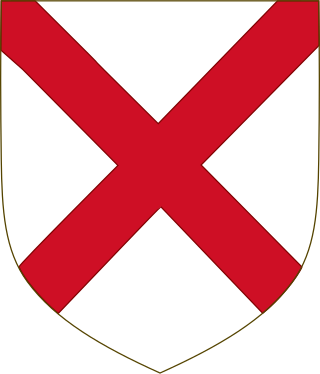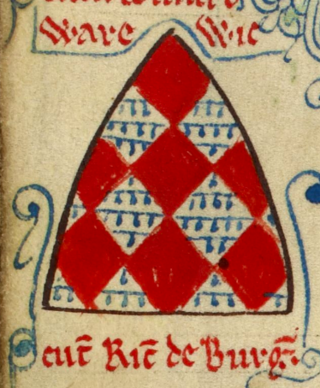Related Research Articles

Sligo Abbey was a Dominican convent in Sligo, Ireland, founded in 1253. It was built in the Romanesque style with some later additions and alterations. Extensive ruins remain, mainly of the church and the cloister.

The FitzGerald dynasty is a Hiberno-Norman noble and aristocratic dynasty, originally of Cambro-Norman and Anglo-Norman origin. They have been peers of Ireland since at least the 13th century, and are described in the Annals of the Four Masters as having become "more Irish than the Irish themselves" or Gaels, due to assimilation with the native Gaelic aristocratic and popular culture. The dynasty has also been referred to as the Geraldines and Ireland's largest landowners. They achieved power through colonisation and the conquest of large swathes of Irish territory by the sons and grandsons of Gerald de Windsor. Gerald de Windsor was the first Castellan of Pembroke Castle in Wales, and became the male progenitor of the FitzMaurice and FitzGerald Dynasty. His father, Baron Walter FitzOther, was the first Constable and Governor of Windsor Castle for William the Conqueror, and was the Lord of 38 manors in England, making the FitzGeralds one of the "service families" on whom the King relied for his survival. Some of its members became the Black Knights, Green Knights and White Knights.

Richard Mór de Burgh, 1st Lord of Connacht, was an Anglo-Norman aristocrat who was Seneschal of Munster and Justiciar of Ireland (1228–32).

Felim O'Connor was king of Connacht in Ireland, having been proclaimed king by Richard Mór de Burgh in 1230, he reigned proper from 1233 until 1265. Felim died in that year and was buried in the Dominican Priory in Roscommon which he founded in 1253. On his accession Felim inherited many problems from his predecessors, having his territory limited to essentially County Roscommon and having to deal with an increase of English and Welsh settlers in the kingdom. Felim attempted to maintain both a loyal and personal relationship with Henry III King of England, hoping he would limit the influence of de Burgh and other powerful Anglo-Norman magnates in Connacht, but this policy of appeasement produced few concrete results. During Felim's reign the lands of the Ua Conchobair became limited to the five 'royal cantreds', essentially County Roscommon. Felim notably adopted aspects of Anglo-Norman culture as seen in his English style effigy and seal.
Events from the year 1346 in Ireland.
Events from the year 1257 in Ireland.
Brian O'Neill, also known as Brian "of the battle of Down" O'Neill, was the High King of Ireland from 1258 to 1260.
Events from the year 1345 in Ireland.
John FitzThomas was an Anglo-Norman in the Peerage of Ireland, as 4th Lord of Offaly from 1287 and subsequently as 1st Earl of Kildare from 1316.
Meyler de Bermingham was an Anglo-Irish lord, founder of Athenry.
Maurice FitzMaurice FitzGerald was an Irish magnate, soldier, and Justiciar of Ireland from 1272 to 1273. His family would come to epitomise the ideal of cultural synthesis in Ireland, becoming "more Irish than the Irish themselves", fusing Gaelic and Norman customs in Irish identity. "But others say he never enjoyed that lordship himself, but that it passed to the son and grandson of his eldest brother Gerald."
Maurice Fitzmaurice FitzGerald I, 2nd Lord of Offaly was an Anglo-Norman peer, soldier, and Justiciar of Ireland from 1232 to 1245. He mustered many armies against the Irish, and due to his harsh methods as Justiciar, he received criticism from King Henry III of England. He was succeeded as Lord of Offaly by his son, Maurice FitzGerald, 3rd Lord of Offaly.
Thomas de Clare, Lord of Thomond was an Anglo-Norman peer and soldier. He was the second son of Richard de Clare, 6th Earl of Gloucester and his wife Maud de Lacy, Countess of Gloucester. In 1272 he served a term as Lieutenant of the Duchy of Aquitaine. On 26 January 1276 he was granted the Lordship of Thomond by Edward I of England; he spent the next eight years attempting to conquer it from the O'Brien dynasty, kings of Thomond.

Ulick Fionn Burke, 6th Clanricarde or Mac William Uachtar was an Irish chieftain and noble.

Richard Óg de Burgh, 2nd Earl of Ulster and 3rd Baron of Connaught, called The Red Earl, was one of the most powerful Irish nobles of the late 13th and early 14th centuries and father of Elizabeth, wife of King Robert the Bruce of Scotland.
Mag Máilin was the surname of a family associated with County Roscommon and its surrounding counties.
Clarus Mag Máilin, Irish monk, fl. 1215-51.

Cairbre Drom Cliabh was an Irish túath in the ancient confederation of Íochtar Connacht, now County Sligo in the west of Ireland. It is now represented by the barony of Carbury. Also known as Cairbre na Catha. It existed from at least the 6th century to the 16th century AD.
The town of Sligo was founded in 1243 AD by the Norman knight Maurice Fitzgerald and Fedlim O'Conchobar the Rí Coiced of Connacht. Norman influence appears to have lasted for about 60 years. From around 1310, after the Gaelic resurgence, the town existed well within the Gaelic cultural zone and developed on the Sligeach (Garavogue) river under the O’Conchobhar Sligigh dynasty and within the Irish túath of Cairbre Droma Cliabh as part of the Gaelic confederation of Iochtar Connacht until the creation of County Sligo by the English Lord Deputy Henry Sidney in 1561.
Geoffrey de Marisco was the justiciar of Ireland. He held considerable power in Ireland during the reign of King John and the early reign of Henry III. Among his activities were helping to prosecute wars against the native Irish rulers. In 1245 he was accused of treason and executed shortly thereafter.
References
- ↑ "The site of Sligo Castle". Sligo Town Ireland. Retrieved 23 September 2022.
- ↑ "Castle Connor History -- O'Connor Sligo | Kilmacteige Parish Genealogy - South Sligo, Ireland". kilmacteige.com. Retrieved 2 March 2019.
- ↑ "Castles of Ireland - County Sligo". sites.rootsweb.com. Retrieved 2 March 2019.
- ↑ Annals of Ireland by the Four Masters as translated into English by Owen Connellan, vol. 2, Irish Roots Cafe, 2003, ISBN 9780940134140 , p. 521 n.2